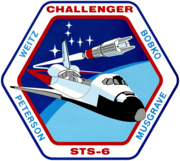STS-6
This article includes a list of general references, but it lacks sufficient corresponding inline citations. (May 2008) |
| COSPAR ID | 1983-026A |
|---|---|
| SATCAT no. | 13968 |
| End of mission | |

 | |
STS-6 was a NASA Space Shuttle mission conducted using Space Shuttle Challenger, carrying the first Tracking and Data Relay Satellite, TDRS-1, into orbit. Launched on 4 April 1983, STS-6 was the sixth shuttle mission and the first of the ten missions flown by Challenger. The mission took off from Kennedy Space Center's launch pad 39A, and landed at Edwards Air Force Base on 9 April. This was the first Space Shuttle mission during which a spacewalk was conducted, and the first in which the Extravehicular Mobility Unit (EMU) was used.
Crew
| Position | Astronaut | |
|---|---|---|
| Commander | Paul J. Weitz Second spaceflight | |
| Pilot | Karol J. Bobko First spaceflight | |
| Mission Specialist 1 | Donald H. Peterson Only spaceflight | |
| Mission Specialist 2 | F. Story Musgrave First spaceflight | |
Mission parameters
- Mass:
- Orbiter Liftoff: 116,457 kilograms (256,744 lb)
- Orbiter Landing: 86,330 kilograms (190,330 lb)
- Payload: 21,305 kilograms (46,969 lb)
- Perigee: 288 kilometres (179 mi)
- Apogee: 295 kilometres (183 mi)
- Inclination: 28.5°
- Period: 90.4 min
Spacewalk
- Musgrave and Peterson – EVA 1
- EVA 1 Start: 7 April 1983, 21:05 UTC
- EVA 1 End: 8 April 1983, 1:15 UTC
- Duration: 4 hours, 10 minutes
Mission background
The mission was originally scheduled to launch on 20 January 1983. However, a hydrogen leak in one of the orbiter's main engines was discovered. Later, after a flight readiness firing of the main engines on 25 January 1983, fuel line cracks were found in the other two engines. A spare engine replaced the engine with the hydrogen leak, and the other two engines were removed, repaired and reinstalled.
While the engine repairs were underway, a severe storm caused contamination of the mission's primary cargo, the first Tracking and Data Relay Satellite, TDRS-1, while it was in the Payload Change-out Room on the Rotating Service Structure at the launch pad. Consequently, the satellite had to be taken back to its checkout facility, where it was cleaned and rechecked. The Payload Change-out Room and the payload bay also had to be cleaned.
It was the last 4-person crew mission until STS-135 (Atlantis) which launched on 8 July 2011.
Mission summary
On 4 April 1983, STS-6, the first Challenger mission, lifted off at 13:30 EST. It marked the first use of a new lightweight external tank and lightweight SRB casings.
STS-6 carried a crew of four – Paul J. Weitz, commander; Karol J. Bobko, pilot; Donald H. Peterson and Story Musgrave, both mission specialists. Using new spacesuits designed specifically for the Space Shuttle program, Peterson and Musgrave successfully accomplished the program's first extravehicular activity (EVA), performing various tests in the orbiter's payload bay. Their spacewalk lasted 4 hours and 17 minutes.
Although the 5,000-lb. TDRS was successfully deployed from Challenger, its two-stage booster rocket, the Inertial Upper Stage (IUS), tumbled out of control, placing the satellite into a low elliptical orbit. Fortunately, the satellite contained extra propellant beyond what was needed for its attitude control system thrusters, and during the next several months the thrusters were fired at carefully-planned intervals gradually moving TDRS-l into its geosynchronous operating orbit, thus saving the $100-million satellite.
Other STS-6 cargo included three GAS canisters, and the continuation of the Mono-disperse Latex Reactor and Continuous Flow Electrophoresis experiments.
Challenger returned to Earth on 9 April 1983 at 10:53 am PST, landing on Runway 22 at Edwards AFB. During the mission, it completed 80 orbits, traveling 2 million miles in 5 days, 23 minutes and 42 seconds. It was flown back to KSC on 16 April 1983.
-
The TDRS is deployed.
-
Musgrave during the EVA.
-
Musgrave, left, and Peterson float in Challenger's cargo bay during the EVA.
Mission insignia
The six white stars in the upper blue field of the mission patch indicate the flight's numerical designation in the Space Transportation System's mission sequence.
Wake-up calls
NASA began a tradition of playing music to astronauts during the Gemini program, and first used music to wake up a flight crew during Apollo 15. Each track is specially chosen, often by the astronauts' families, and usually has a special meaning to an individual member of the crew, or is applicable to their daily activities.[1]
| Flight Day | Song | Artist/Composer |
|---|---|---|
| Day 2 | "Cadets on Parade" | Air Force Academy Band |
| Day 3 | "Teach Me Tiger" | April Stevens |
| Day 4 | "Theme from F-Troop" | |
| Day 5 | "The Poor Co-pilot" | Oscar Brand |
| Day 6 | "Ode to the Lions" | Rusty Gordon |
See also
- Spaceflight
- Space Shuttle program
- Space Shuttle Challenger
- Space Shuttle Challenger disaster
- List of space shuttle missions
- List of spacewalks and moonwalks
- List of human spaceflights chronologically
References
![]() This article incorporates public domain material from websites or documents of the National Aeronautics and Space Administration.
This article incorporates public domain material from websites or documents of the National Aeronautics and Space Administration.
- ^ Fries, Colin (25 June 2007). "Chronology of Wakeup Calls" (PDF). NASA. Retrieved 13 August 2007.




